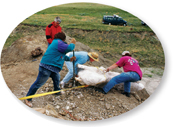19.2 Patterns and Processes of Evolution
 What processes influence whether species and clades survive or become extinct?
What processes influence whether species and clades survive or become extinct? How fast does evolution take place?
How fast does evolution take place? What are two patterns of macroevolution?
What are two patterns of macroevolution? What evolutionary characteristics are typical of coevolving species?
What evolutionary characteristics are typical of coevolving species?
macroevolutionary patterns
background extinction
mass extinction
gradualism
punctuated equilibrium
adaptive radiation
convergent evolution
coevolution
Concept Map Construct a concept map that includes the patterns of macroevolution shown in this lesson.
THINK ABOUT IT The fossil record shows a parade of organisms that evolved, survived for a time, and then disappeared. More than 99 percent of all species that have lived on Earth are extinct. How have so many different groups evolved? Why are so many now extinct?
Speciation and Extinction
 What processes influence whether species and clades survive or become extinct?
What processes influence whether species and clades survive or become extinct?
The study of life's history leaves no doubt that life has changed over time. Many of those changes occurred within species, but others occurred in larger clades and over longer periods of time. These grand transformations in anatomy, phylogeny, ecology, and behavior, which usually take place in clades larger than a single species, are known as macroevolutionary patterns. The ways new species emerge through speciation, and the ways species disappear through extinction, are among the simplest macroevolutionary patterns. The emergence, growth, and extinction of larger clades, such as dinosaurs, mammals, or flowering plants are examples of larger macroevolutionary patterns.
Macroevolution and Cladistics Paleontologists study fossils to learn about patterns of macroevolution and the history of life. Part of this process involves classifying fossils. Fossils are classified using the same cladistic techniques, based on shared derived characters, that are used to classify living species. In some cases, fossils are placed in clades that contain only extinct organisms. In other cases, fossils are classified into clades that include living organisms.
Remember that cladograms illustrate hypotheses about how closely related organisms are. Hypothesizing that a fossil species is related to a living species is not the same thing as claiming that the extinct organism is a direct ancestor of that (or any other) living species. For example, Figure 19–9 does not suggest that any of the extinct species shown are direct ancestors of modern birds. Instead, those extinct species are shown as a series of species that descended, over time, from a line of common ancestors.
 In Your Notebook Explain what macroevolution is and how fossils can show macroevolutionary trends.
In Your Notebook Explain what macroevolution is and how fossils can show macroevolutionary trends.

FIGURE 19–8 Paleontologists at Work The white covering protects the fossils until they can reach a museum.

Table of Contents
- Formulas and Equations
- Applying Formulas and Equations
- Mean, Median, and Mode
- Estimation
- Using Measurements in Calculations
- Effects of Measurement Errors
- Accuracy
- Precision
- Comparing Accuracy and Precision
- Significant Figures
- Calculating With Significant Figures
- Scientific Notation
- Calculating With Scientific Notation
- Dimensional Analysis
- Applying Dimensional Analysis




